Past Exhibitions
ABL Past Exhibitions
Mythic Women
Archetypal Symbology in “Fifine at the Fair”
Hankamer Treasure Room • Armstrong Browning Library
August 17, 2022 – December 31, 2022
An exhibit curated by Katrina L. Gallegos
M.A. Candidate Department of Museum Studies
The Victorians are remembered for being conservative, in their dress, their customs, and their culture. Therefore, it is surprising to see provocative subjects explored in Victorian art, literature, and poetry. They explored topics such as desire, infidelity, gender, and sexuality. They used their art as an expressive outlet in response to a restrictive society.
Because of the conservative nature of the dominant social culture authors and artists used coded language to express their inner desires, thoughts, emotions. This coded language often employed classical symbols from Roman and Greek antiquity. They also used this language to prove their intellectual prowess among their peers. For modern readers and viewers these examples may not seem provocative because the authors and artists used complicated language and obscure references. Some memorable authors and artists who were provocative are Robert Browning, Gabriel Dante Rossetti, Lord Byron, and Julia Margaret Cameron.
This exhibition decodes the complex language found in Robert Browning’s poem, “Fifine at the Fair”. Specifically, examining themes of sexuality, desire, the male gaze, and social class on the poem’s 150th anniversary.
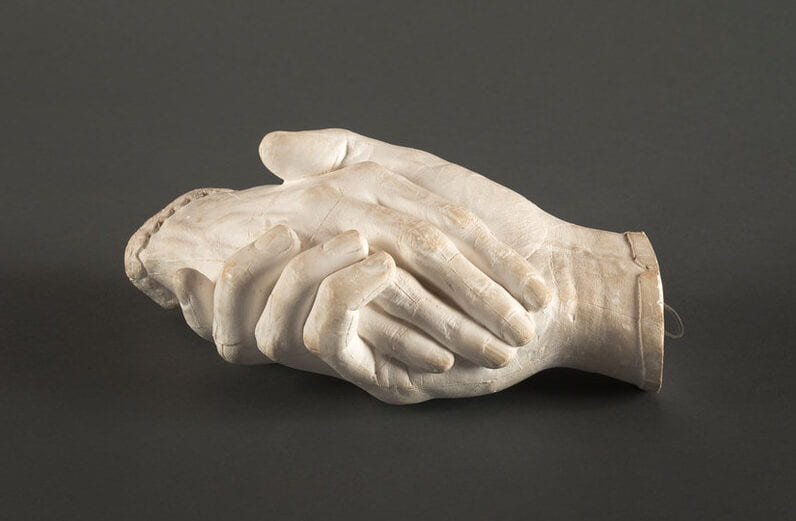
This exhibition explores the lives and works of Robert Browning (1812-1889) and Elizabeth Barrett Browning (1806-1861) through three dominant themes: Injustice, Nature, and Faith. Though the Brownings commented on these issues a while ago, they did so in forward-thinking ways that remain relevant to the twenty-first century. We hope that our exhibit pages will engage you in a dialogue about these issues, and help you realize that the advice of poets past may still be valid today.
This exhibition was curated by students in a senior seminar on the Brownings (ENG 4364), taught by Dr. Joshua King, department of English (Joshua_King@baylor.edu) in Fall 2020, with exhibition assistance by Laura French, Curator of the Armstrong Browning Library (Laura_J_French@baylor.edu), and Erik Swanson, Exhibits Curator and Coordinator, Central Libraries (Erik_Swanson@baylor.edu).
Hankamer Treasure Room, Second Floor
Collecting the Brownings, which was on display in the Armstrong Browning Library's Hankamer Treasure Room from February 3-December 2020, features a chronological display of the British first editions of Robert and Elizabeth Barrett Browning from the personal library of Melvin H. Schuetz, Assistant to the Curators, Armstrong Browning Library.
Melvin retired on May 1, 2020, after 26 years of service to Baylor University.
1 September 2019 through 15 December 2019
"EVERY COMMON BUSH AFIRE WITH GOD": DIVINE ENCOUNTERS IN THE LIVING WORLD
Hankamer Treasure Room, Second Floor
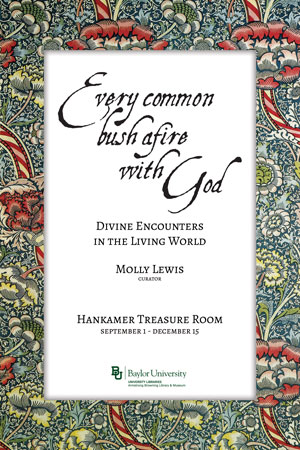
Many nineteenth-century British writers were deeply disturbed by the destructive consequences of the Industrial Revolution on their natural environment, both as artists of the written word and as religious thinkers. Much of this concern stems from their conviction that we encounter God through the living world of plants, animals, water, and sky. These writers believed that humanity is not alone in bearing the image of God; all of creation reflects the divine. Recognizing this divine reflection in nature makes prayerful communion with God possible. But, by extension, harming the earth can further separate us from God. The writers and artists represented here were inspired in their own creative acts - works of art like poetry and painting - as they paid attention to and cared for the world of nature around them. Through their words and images, we may better understand how a robust faith encourages us towards better care for creation in the twenty-first century.
An exhibition created by Molly Lewis, Armstrong Browning Library Summer Intern
1 April 2019 through 31 August 2019
SONNETS FROM THE PORTUGUESE IN PRINT
Hankamer Treasure Room, Second Floor
Elizabeth Barrett Browning wrote Sonnets from the Portuguese during her courtship with Robert Browning. She was initially reluctant to publish the love sonnets, because they were deeply personal to her. First published in Poems (1850), She titled them Sonnets from the Portuguese to pretend they were translated works. Speculation began immediately that the poems were original and not translations which the poetess eventually confirmed. Sonnets from the Portuguese proved to be very popular and remains so to this day. This exhibit showcases 15 examples of Sonnets from the Portuguese from the Armstrong Browning Library's collection.
An exhibition created by Emma Whipkey, Armstrong Browning Library Graduate Student Assistant
1 January 2019 through 1 April 2019
THE VICTORIAN COLLECTION AT THE ARMSTRONG BROWNING LIBRARY & MUSEUM
Hankamer Treasure Room, Second Floor
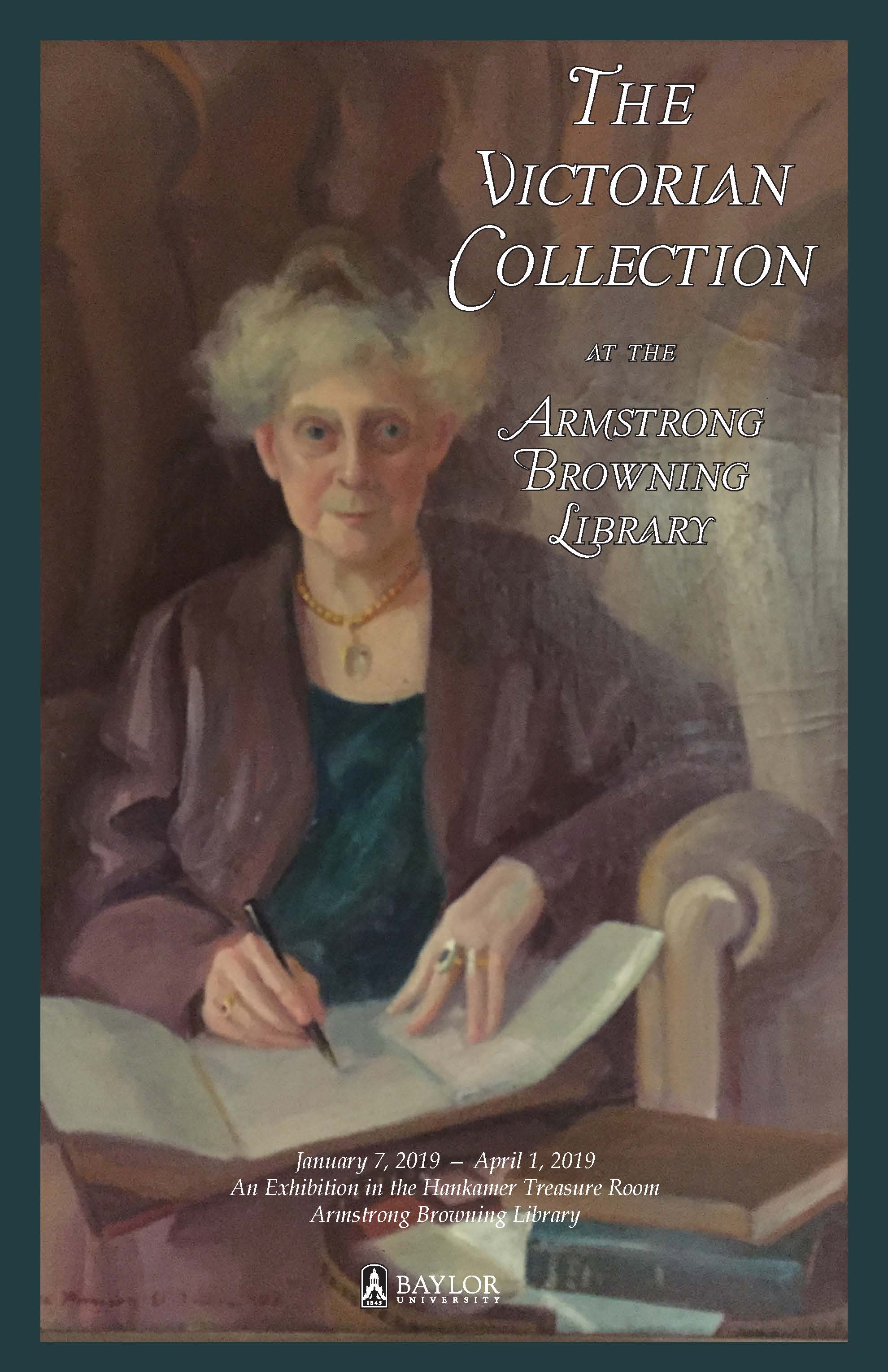
In addition to the unparalleled collection of correspondence written and received by the Victorian poets Robert Browning and Elizabeth Barrett Browning, the Armstrong Browning Library houses a large collection of Victorian letters and manuscripts connected to other prominent and lesser known British and American figures. This collection includes letters and manuscripts from many notable nineteenth-century literary figures such as Charles Dickens, William Wordsworth, Samuel Taylor Coleridge, Thomas Carlyle, John Henry Newman, George MacDonald, and John Ruskin. The collection also includes letters and manuscripts from the fields of science, exploration, religion, politics, the arts, music, and the theater. The letters and manuscripts in this growing collection, which currently contains over 3,000 items, has been digitized and can be browsed and searched by date, author, keyword, or first line of text at the Baylor University Libraries Digital Collection.
1 October 2018 through 1 April 2019
"ORPHANS OF EARTHLY LOVE": Elizabeth Barrett Browning's Protest for Working Children
Honoring the 175th anniversary of The Cry of the Children
Hankamer Treasure Room, Second Floor
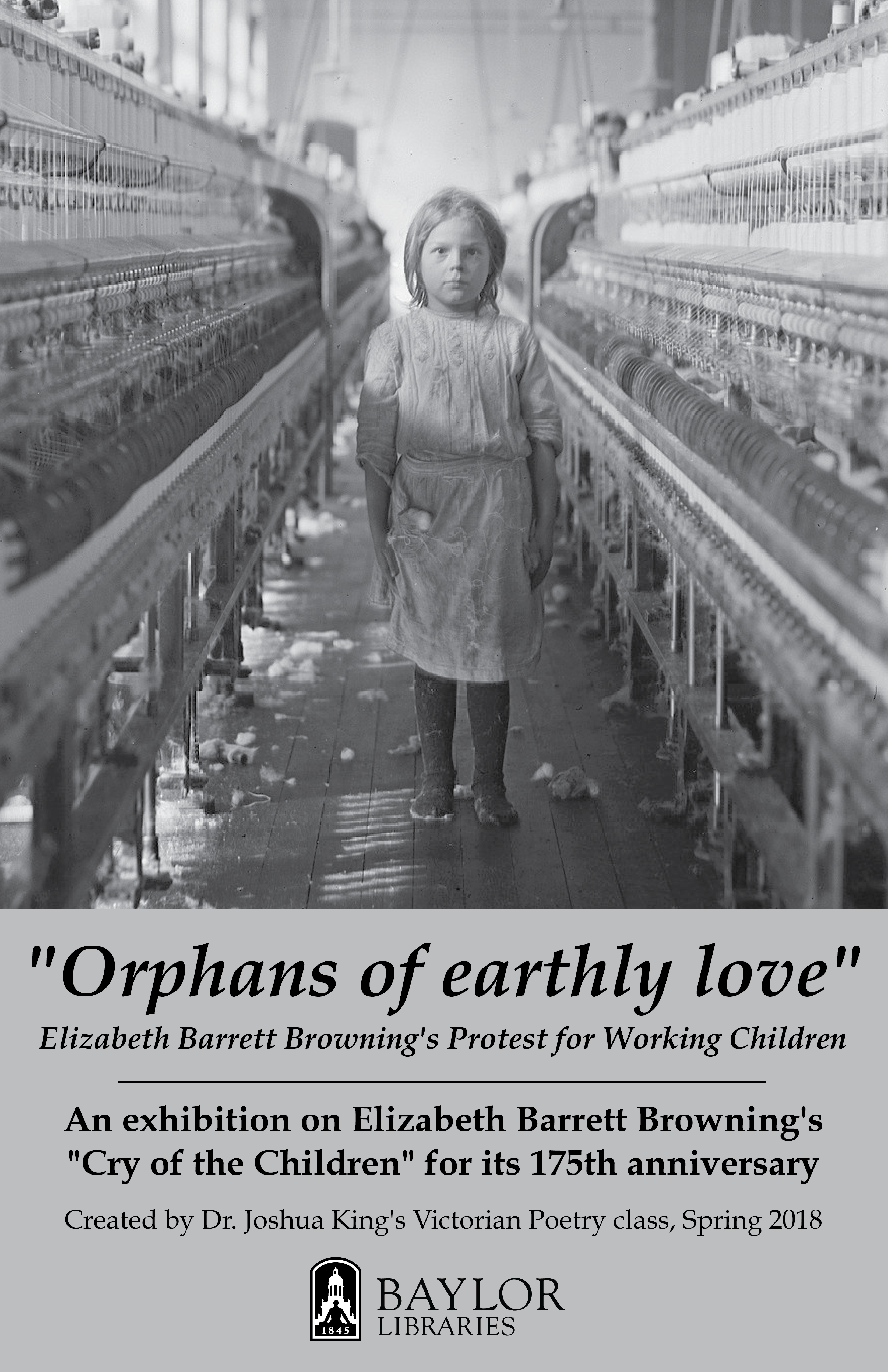
Can a child be an orphan if her parents are alive?
Yes, Elizabeth Barrett Browning (EBB) claims in The Cry of the Children (1843). EBB wrote this poem in response to shocking government reports about child labor in mines and factories. She opens asking British readers to hear a cry for relief coming through the reports: "Do ye hear the children weeping, O my brothers?" EBB invites readers to see themselves as "brothers" in a national family that has ignored the cries of its working children, abandoning them as "orphans of earthly love."
Only one letter stands between "hear" and "heart."
EBB asks readers to take the cry they hear in her poem to heart; not acting will crush hearts. "How long," EBB imagines the children asking their nation, "will you" trample each "child's heart" to pursue your profit?
We hope you'll join us in considering these questions as you journey through our exhibition.
Dr. Joshua King's Victorian Poetry Class (Spring 2018)
2 June 2018 through 6 January 2019
WHITE STAR LINES: Titanic Connections at the Armstrong Browning Library
Hankamer Treasure Room, Second Floor
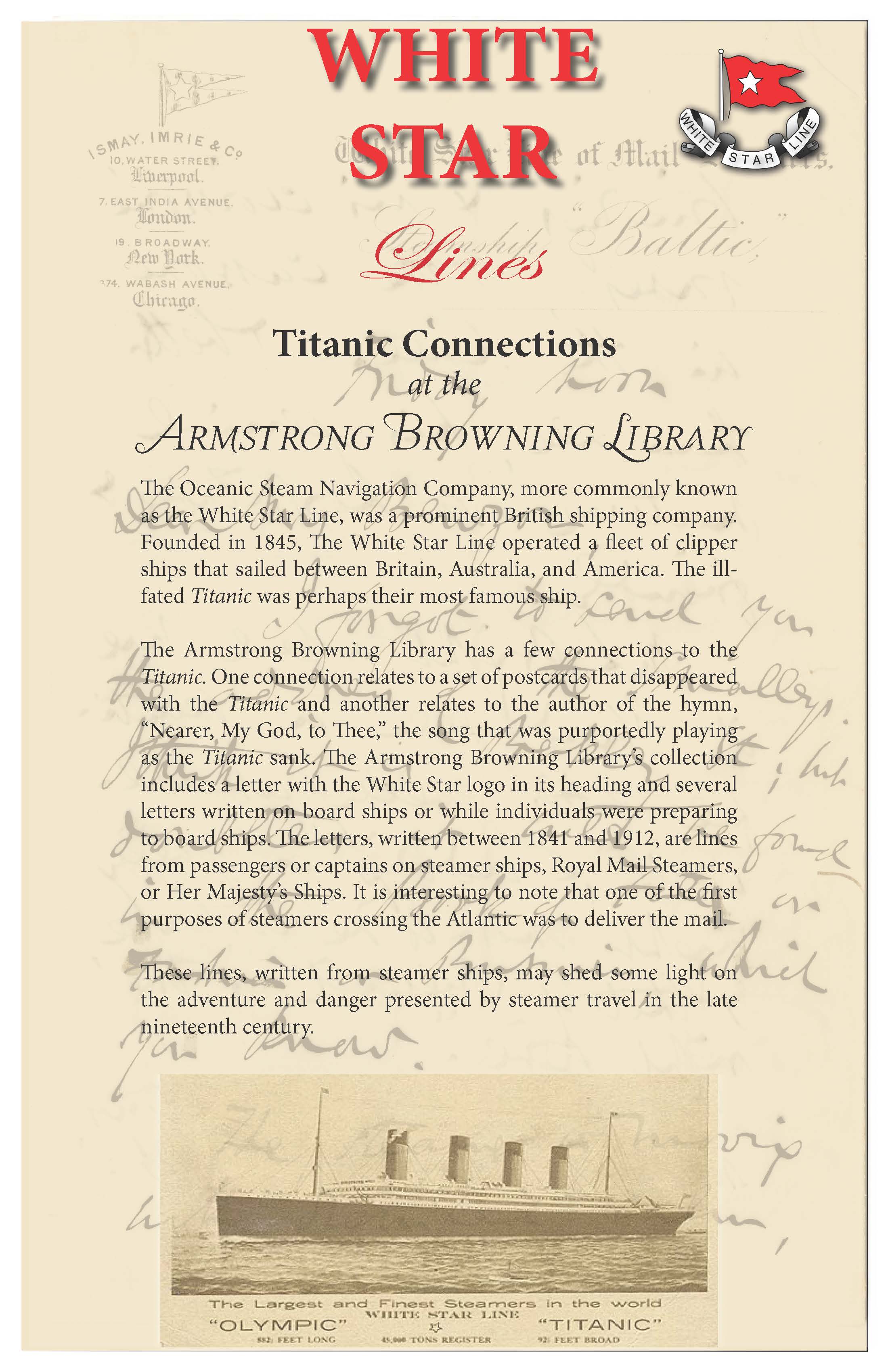
The Oceanic Steam Navigation Company, more commonly known as the White Star Line, was a prominent British shipping company. Founded in 1845, The White Star Line, operated a fleet of clipper ships that sailed between Britain, Australia, and America. The ill-fated Titanic was perhaps their most famous ship. The Armstrong Browning Library has a few connections to the Titanic. One connection relates to a set of postcards that disappeared with the Titanic and another relates to the author of the hymn, “Nearer, My God, to Thee,” the song that was purportedly playing as the Titanic sank. The Armstrong Browning Library's collection includes a letter with the White Star logo in its heading and several letters written on board ships or while individuals were preparing to board ships. The letters, written between 1841 and 1912, are lines from people who were passengers on SS (Steamer Ships), RMS (Royal Mail Steamers), or HMS (Her Majesty’s Ship). It is interesting to note that one of the first purposes of steamers crossing the Atlantic was to deliver the mail. These lines, written from steamer ships, may shed some light on the adventure and danger presented by steamer travel in the late nineteenth century.
1 July 2018 through 1 September 2018
THE LITERARY NETWORK OF ROBERT BROWNING AND ELIZABETH BARRETT BROWNING
Hankamer Treasure Room, Second Floor
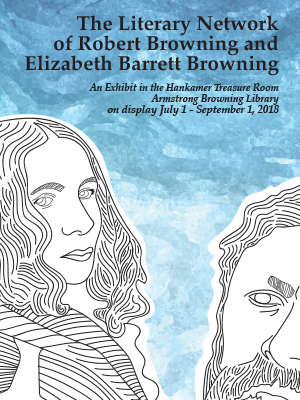
“The image of a ‘solitary genius’ creating art in isolation has been handed down to us from the Romantics; this is ironic because the nineteenth century boasts some of the most fascinating relationships between famous literary figures. Authors did not, in fact, work alone but often collaborated, either directly by each person contributing something to the final piece or indirectly through the influence of conversations, interactions, or from reading one another’s works.” In Fall 2017, students in Dr. Kristen Pond’s upper-level English course, “Literary Networks in the Nineteenth and Early Twentieth Centuries,” explored the relationships between writers of the Romantic, Victorian, and Modernist Periods. Utilizing the letters, manuscripts, rare books, and other collection materials at the Armstrong Browning Library, the students ended their semester by curating an exhibition that uncovered connections between one particular literary figure and Robert and Elizabeth Barrett Browning—the centers of the literary network for the course—or another significant literary figure.
22 January 2018 through 1 June 2018
ROMANTICISM AT THE ABL: PERCEPTIONS AND RELATIONSHIPS
Hankamer Treasure Room, Second Floor
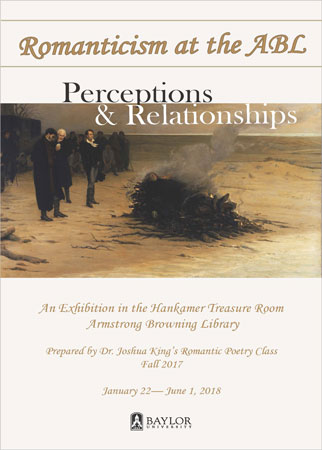
Perceptions and relationships act like gravity, secretly guiding how we move through the world. Which of us does not feel the pull of these questions— How do others see me and the world around us? How do they see those I love or admire? How will we be remembered when we are gone?
These same questions, this exhibition reveals, shaped the lives and legacies of important British Romantic authors and the writers who followed them. Sisters nurtured the social standings of their brothers, friends revealed their tensions in their publications, sons wrote their way out from under the literary shadows of parents, and widows curated the memories of husbands.
Yet perceptions and facts rarely—if ever—perfectly coincide. Consider the image we have chosen for our exhibition, a famous painting of the funeral of Percy Shelley, a Romantic poet who tragically drowned at twenty-nine. It includes many of the people you will meet in our display cases. Nearly every detail—Shelley's body rests immaculate on the pyre; the poet Lord Byron stares into the distance in the foreground; Shelley's wife Mary kneels grieving in the background—is inaccurate. Shelley's body was disfigured by the sea, Byron was shocked and sought relief in a swim, and Mary was not present. Yet this painting still shapes the way people around the world view Shelley, his death, and those who loved him.
As you see our displays about these and other authors, ask yourself: how are my perceptions of these authors, and their relationships, being shaped?
An exhibition created by students in Dr. Joshua King's Romantic Poetry class, fall 2017.
28 April 2017 through 6 November 2017
CHOOSING THE WRITE RIGHT WORDS
Revision & Reception in The Victorian Period
Hankamer Treasure Room, Second Floor
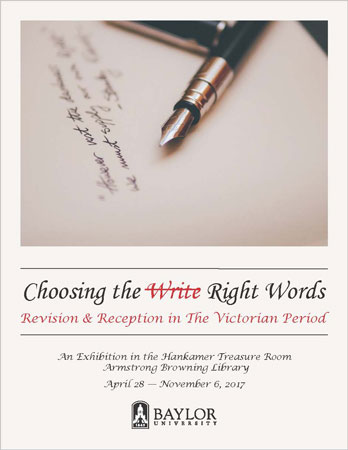
You will never see the discarded drafts of this introduction. What were they like? What response was the author hoping to achieve through that revision? Will the next reader react to these words the same way you are?
When words are printed and public, we tend to forget that they could have been different, and that two people rarely read them the same way. This exhibition invites you to wonder why important Victorian poets discarded so many of their first attempts, and what this says about their concern for their reception and public image. These poets were not the only ones revising: readers gave diverse meanings to their poems, and editors arranged their poems in ways that shaped how they were interpreted. The poets themselves were revised as reviewers and artists influenced their public perception. What revisions will you notice, what new interpretations will you create, as you journey through the exhibition?
An exhibition created by students in Dr. Joshua King's Victorian Poetry class, Spring 2017
10 February 2017 through 21 April 2017
MAKING CONNECTIONS:
Literary Networks in the 19th and Early 20th Centuries
Hankamer Treasure Room, Second Floor
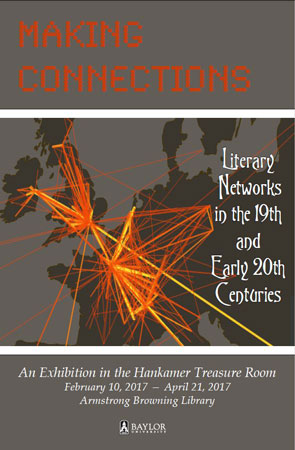
In fall 2016, students in Dr. Kristen Pond’s upper-level English course, “Literary Networks in the Nineteenth and Early Twentieth Centuries,” explored the relationships between writers of the Romantic, Victorian, and Modernist Periods and the influences they had on each other’s works. “Authors did not, in fact, work alone,” Dr. Pond argued, “but often collaborated, either directly by each person contributing something to the final piece or indirectly through the influence of conversations, interactions, or from reading one another’s works.” Utilizing the letters, manuscripts, rare books, and other collection materials at the Armstrong Browning Library, the students ended their semester by curating an exhibition that uncovered connections between one particular literary figure and Robert and Elizabeth Barrett Browning—the centers of the literary network for the course—or another significant literary figure.
The Armstrong Browning Library would like to thank Dr. Kristen Pond and the students who made this exhibition possible:
Marcus Appleyard, Rebecca Causey, Victoria Corley, Annie Dang, Taylor Ferguson, Casey Froehlich, Madelynn Lee, Mollie Mallory, Anne McCausland, Emily Ober, Shannon Ristedt, Chris Solis, Alexander Stough, Alex Ueckert, Baylee Versteeg, and Jonathan White.
22 August 2016 through 22 December 2016
EDITING SHAKESPEARE:
The Eighteenth-Century Editions
Hankamer Treasure Room, Second Floor
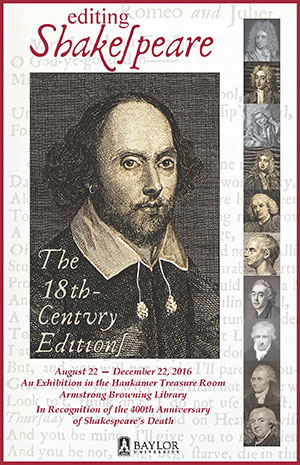
This year marks the 400th anniversary of William Shakespeare's death, which occurred on April 23, 1616. In recognition of this important anniversary, the Armstrong Browning Library presents this exhibit showcasing ten rare eighteenth-century editions of Shakespeare's works. These editions are part of the Stokes Shakespeare Collection which was donated to the ABL by William N. Stokes, Jr., a former student of the library's founder, Dr. A.J. Armstrong.
The editions exhibited here represent a significant period in Shakespearian scholarship. The eighteenth century saw a series of editors produce successive editions of Shakespeare's works. As the century progressed, ideas about authorship, in general, and Shakespeare, in particular, changed. There was increased significance placed on the preservation of texts in their original versions.
Shakespeare himself published none of his own plays, and the earliest editions of them, published after his death, contained errors introduced by compilers, printers, and compositors. Despite these challenges, several eighteenth-century editors attempted to approximate Shakespeare's genuine text, each bringing their own unique style to the work. Each edition is different, making them interesting to examine individually and as a whole collection.
The editorial changes introduced in these volumes both reflected and contributed to a gradual cultural sanctification of Shakespeare and canonization of his words. Viewers of this exhibit are encouraged to reflect on the weighty cultural and literary significance of these editions.
—This exhibit was curated by ABL intern Hannah Schwartz, a junior University Scholar with concentrations in linguistics and English literature.
1 October 2015 through 10 March 2016
A WORLD OF THEIR OWN:
Children's Literature at the Armstrong Browning Library
Hankamer Treasure Room, Second Floor
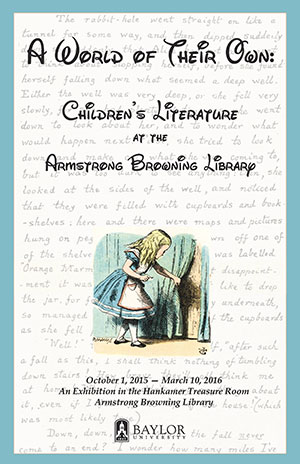
The 2015 Baylor Libraries Symposium, “Alice at 150,” held October 6th through 9th, recognized the 150th anniversary of the publication of the children’s classic Alice’s Adventures in Wonderland, authored by Charles Lutwidge Dodgson using the pen name Lewis Carroll. When the symposium theme was announced, it brought to mind a project I had been considering for some time—an inventory of children’s literature held by the Armstrong Browning Library. In the development of ABL’s book collection, children’s literature has never been a focus. The only items actively collected in this area have been editions of Robert Browning’s poem “The Pied Piper of Hamelin.” I knew, however, that other books for children were in the collection. After extensive searches of the Baylor University Libraries’ Online Catalog, using keywords and subject headings related to literature for children, I was shocked at the number of titles located at the ABL. In addition to the over 150 editions of The Pied Piper of Hamelin, I uncovered over 240 other children’s literature titles. So, not only are we recognizing Lewis Carroll and 150 years of Alice, we are celebrating the discovery of a hidden collection by presenting this exhibition, A World of Their Own: Children’s Literature at the Armstrong Browning Library.
Included among the books, tracts, and pamphlets in this exhibition are fables, children’s classics, children’s literature by famous authors, instructional literature, and poetry for children. As the nineteenth century progressed and literacy achieved new heights, publishers began to recognize the financial benefits of providing books for children, particularly for the Christmas and Easter markets. Children’s literature, as a genre, began to reach maturity. The books offered for children began to include not only instructional materials, but some, like Alice’s Adventures in Wonderland, that opened a world of nonsense, fantasy, or adventure—a world of their own—to the children of the period.
—Cynthia A. Burgess, Librarian/Curator of Books and Printed Materials
ARMSTRONG'S STARS
Hankamer Treasure Room, Second Floor
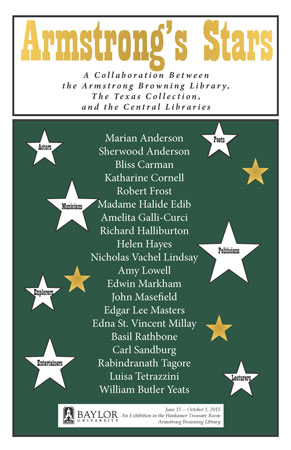
During his 40 hears as chair of Baylor's English Department from 1912-1952, Dr. A.J. Armstrong built the world's largest collection of materials documenting the life and legacy of Robert Browning, the 19th-century poet he greatly admired. He also introduced Baylor and Waco to the literary, musical, and dramatic talents of the period. Pulitzer Prize-winning poets, world-renowned musicians, and stars of stage and screen, among others, made appearances in Waco at the invitation of Dr. Armstrong, whose primary purpose in these endeavors was "to give [Baylor] students the opportunity to come in contact with world forces and world geniuses." "I believe it is one thing," Armstrong wrote in a letter to Baylor President Samuel Palmer Brooks in 1921, "they will remember longer than anything else connected with their schooldays."
Armstrong's Stars, a collaboration between the Armstrong Browning Library, The Texas Collection, and the Central Libraries, highlights this memorable part of Baylor's history.
20 March 2015 through 1 June 2015
IMAGINING CHARITY FOR ALL: ANTI-SLAVERY WRITINGS AT THE ARMSTRONG BROWNING LIBRARY
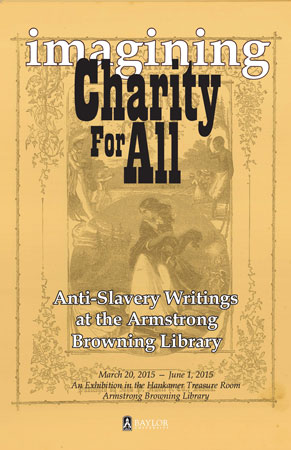
When Harriet Beecher Stowe (1811-1896), abolitionist and author of Uncle Tom's Cabin, met Abraham Lincoln at the White House in 1862, the president is said to have welcomed her by saying, "So you're the little woman who wrote the book that started this Great War!" But Stowe was not alone. As the Baylor University Libraries observe the 150th anniversary of the end of the Civil War by mounting exhibits under the overarching theme "with charity for all," taken from President Lincoln's Second Inaugural Address, the Armstrong Browning Library's exhibit Imagining Charity for All highlights works by some of the men and women who, like Stowe, used their literary talent to promote freedom and equality. The items on display from the collection of the Armstrong Browning Library represent a small, but powerful, portion of the large body of anti-slavery writings produced prior to and during the Civil War that furthered the cause of ending slavery.
12 September 2014 through 12 January 2015
BEYOND THE BROWNINGS: THE VICTORIAN LETTER AND MANUSCRIPT COLLECTION AT THE ARMSTRONG BROWNING LIBRARY
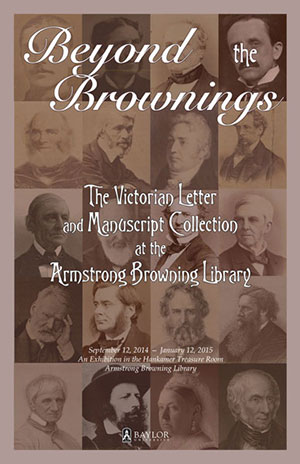
Scholars know the Armstrong Browning Library at Baylor University as a world-class research library devoted to the lives and works of Robert and Elizabeth Barrett Browning. In addition to housing the world’s largest collection of books, letters, manuscripts, and memorabilia related to the Brownings, the library houses a substantial collection of primary and secondary materials related to nineteenth-century literature and culture. The Victorian Letters and Manuscripts Collection includes almost 2,500 items from literary, political, ecclesiastical, scientific, and cultural figures in the nineteenth century. Letters, manuscripts, and books from numerous Victorian figures were featured in the exhibit.
A digital edition of "Beyond the Brownings" is available on the ABL&M blog.
14 February through 12 May, 2014
...FROM AMERICA: THE BROWNINGS' AMERICAN CORRESPONDENTS
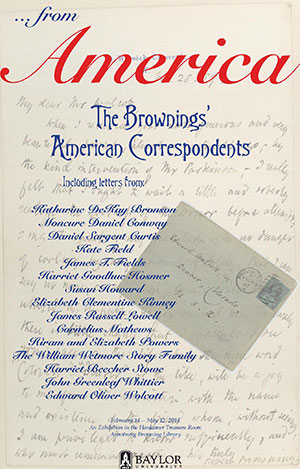
The cataracts and mountains you speak of have been, are, mighty dreams to me "and the great people which, proportionate to that scenery, is springing up in their midst to fill a yet vaster futurity, is dearer to me than a dream. America is our brother-land, and though a younger brother, sits already on the teacher's seat, and expounds the common rights of our humanity. It would be strange indeed if we in England did not love and exult in America--if English poets, of whom I am least if at all, did not receive with peculiar feeling of gratitude and satisfaction the kind welcoming word of American readers. Believe me grateful to America" . . . .
We have one Shakespeare between us--your land and ours--have we not? And one Milton, and now we are waiting for you to give us another. . . .
You would wonder a good deal--but would do so less if you were aware of the seclusion of my life, when I tell you that I never consciously stood face to face with an American in the whole course of it. I never had any sort of personal acquaintance with an American, man or woman. Therefore you are all dreamed dreams to me "Gentle dreams" I may well account you.
--Elizabeth Barrett Browning to Cornelius Mathews, 3 November 1842
In fact, Elizabeth and Robert Browning did meet many Americans face to face. Their American acquaintances included publishers, editors, journalists, poets, novelists, socialites, sculptors, painters, actresses, social activists, and politicians. Although Elizabeth and Robert never traveled to America, they corresponded with these American friends and met many of them socially in their home in Italy and during their stays in England and Europe.
A digital edition of ". . . from America" is available on the ABL&M blog.
7 May through 12 December 2012
GIVING NINETEENTH CENTURY WOMEN WRITERS A VOICE AND A FACE
Do give your ear to me—your heart to me
Do grant this confirmation of yr voice
To my voice, that it may not speak in vain...
This excerpt from a fragment of the poem, "My sisters! Daughters of this fatherland," by Elizabeth Barrett Browning, expresses the challenges Barrett Browning faced as she sought to assert her voice in a predominately male tradition of public poetry in the 1840s.
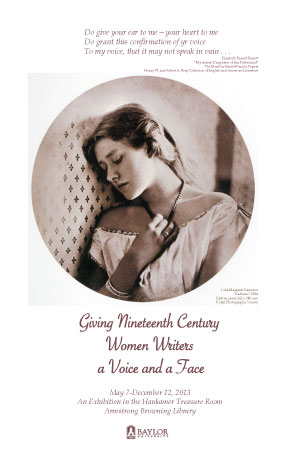
The Giving Nineteenth Century Women Writers a Voice and a Face exhibit featured texts and images of twenty-three nineteenth-century women. These women were mothers, daughters, wives, lovers, friends, poets, novelists, tract writers, storytellers, hymn writers, advocates for social reform, philanthropists, and more.
Women writers included in the exhibit were Hannah More, Maria Edgeworth, Felicia Hemans, Mary Shelley, Mary Russell Mitford, Anna Jameson, Letitia Elizabeth Landon, Sarah Flower Adams, Elizabeth Gaskell, Geraldine Jewsbury, Eliza Cook, Julia Margaret Cameron, Isabella Blagden, Theodosia Trollope, George Eliot, Jean Ingelow, Anne Thackeray Ritchie, Lucy Larcom, Christina Rossetti, Frances Ridley Havergal, Julia Augusta Webster, Amy Levy, and Michael Field.
Because Victorian women were expected to find fulfillment in marriage and children, typical nineteenth-century women's writing included children's literature, flowery poetry, and religious poems. However, these works, important in themselves, also gave nineteenth-century women a platform for speaking to gender inequality and social reform. Some women writers of the period broke from convention and also produced literature similar to their male counterparts, such as novels and dramatic works. Some were well liked by the public and respected by their fellow authors, both male and female.
Most of the nineteenth-century English writers were well acquainted with one another. They communicated frequently and critiqued each other's works. Many literary individuals were even related, by blood or by marriage. Robert Browning and Elizabeth Barrett Browning were both in close contact with their contemporaries and the Browning's personal library included works from many of these authors.
Many of the items in the exhibit were drawn from the Armstrong Browning Library's large 19th Century Women Poets Collection, which embraces a range of styles, from simple statements to effusive eulogies. Topics covered include religious themes, ancient Greek and Roman myth, daily life, romance, motherhood, social issues, and local and national history. The 19th Century Women Poets Collection has been digitized and can be viewed online at https://digitalcollections.baylor.edu.
A series of posts on the ABL&M blog details the many fascinating facts that were discovered about these amazing women during the research for the exhibit.
It is the Armstrong Browning Library's sincere hope that through these texts and images that we are able to honor Elizabeth Barrett Browning's wish by giving nineteenth-century women writers a voice and a face.
THE BROWNINGS AND THE MIDDLE EAST
In conjunction with the other libraries at Baylor University, the ABL 2013 spring exhibit complemented the theme Middle East Patterns: Places, Peoples, and Politics.
The Middle East Patterns exhibit extended beyond the ABL and included Moody Memorial Library, The Texas Collection, and the W. R. Poage Legislative Library. The entire exhibit featured over 300 original photographs from Dr. Colbert C. Held, a 1938 alumnus of Baylor, former Foreign Service Officer with the State Department, and retired diplomat-in-residence at Baylor University. Held took more than 19,000 photographs that portray the people and culture of this area.
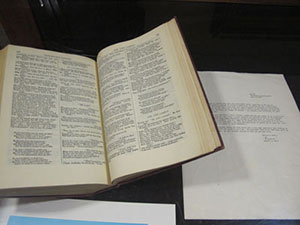
Prominently displayed was the textbook used by Colbert Held when a student in Dr. A. J. Armstrong's Browning class. The two kept in touch regularly until Dr. A's death in 1954, a fact made evident by Dr. Held's letter written in 1949.
The textbook is shown open to a section of Ferishtah's Fancies, a poem that inspired a series of stained glass windows on the third floor of the Armstrong Browning Library. Two of the windows portray scenes from "Mihrab Shah" and "The Melon Seller," which are sections of Ferishtah's Fancies.
On several occasions Robert and Elizabeth Barrett Browning expressed a desire to visit the Middle East, in particular Egypt and the Holy Lands. The couple made tentative plans to travel to Egypt in the winter of 1858, but never made this trip.
Though unable to travel to the Orient, Robert Browning met the Shah of Persia, Jasir al-Din Shah Qajar, on two different occasions, in the summer of 1873 and the summer of 1889. On the first occasion, Browning was invited to a gala dinner in honor of the Shah, which was held at the Duke of Sutherland's home. Guests were seated by rank; and Robert Browning, who had no title, was far down at the end of the table. The Shah noticed Browning in his bright red robes from Balliol College and inquired about his identity. When told Browning was one of England's great poets, the Shah announced that in Iran poets were honored; he demanded that Browning sit next to him. The Duke acquiesced, moving the poet next to the Persian monarch and the Prince of Wales, while he moved to the end of the table.
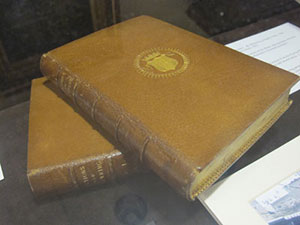
Browning was distressed about this social faux pas and went to his publisher where he requested that two volumes of his Selections be specially bound and stamped with the Sutherland crest. Browning sent the volumes to the Duke as an apology. In 1927 the volumes were presented to Dr. Armstrong by the Duchess of Sutherland.
Middle Eastern influences can also be seen in Browning's furniture selections. An example is the Persian table in the Hankamer Treasure Room.
KING JAMES BIBLE EXHIBITION
In April of 2011 over 100 rare and ancient Bibles from one of the world's largest collections of Bibles and related documents of the Judeo-Christian tradition were on display to enhance the international conference, The King James Bible and the World It Made, 1611-2011.
Sponsored by The Green Collection.
ELIZABETH BARRETT BROWNING Her Diminutive Presence
George Stillman Hillard, a Boston travel author visiting in Florence, made these comments after meeting Robert and Elizabeth Barrett Browning in 1847:
Mrs. Browning is in many respects the correlative of her husband. As he is full of manly power, so she is a type of the most sensitive and delicate womanhood. She has been a great sufferer from ill health, and the marks of pain are stamped upon her person and manner. Her figure is slight, her countenance expressive of genius and sensibility, shaded by a veil of long brown locks, and her tremulous voice often flutters over her words, like the flame of a dying candle over the wick. I have never seen a human frame which seemed so nearly a transparent veil for a celestial and immortal spirit. . . . A union so complete as theirs--in which the mind has nothing to crave nor the heart to sign for--is cordial to behold and soothing to remember.
The items in this exhibit emphasized the petite and diminutive presence of Elizabeth Barrett Browning--the bronze sculpture of her frail hand clasped in the palm of her husband's, the tiny mitts she wore, her personal teapot, the miniature books she cherished, her fragile handwriting illustrated by the famous "How Do I Love Thee?" (Sonnet 43, Sonnets from the Portuguese)--along with the pencil and ink well she used to produce her poetry. All of these relics are available for the public to view.